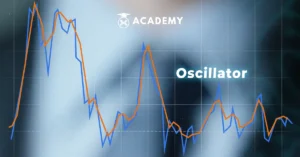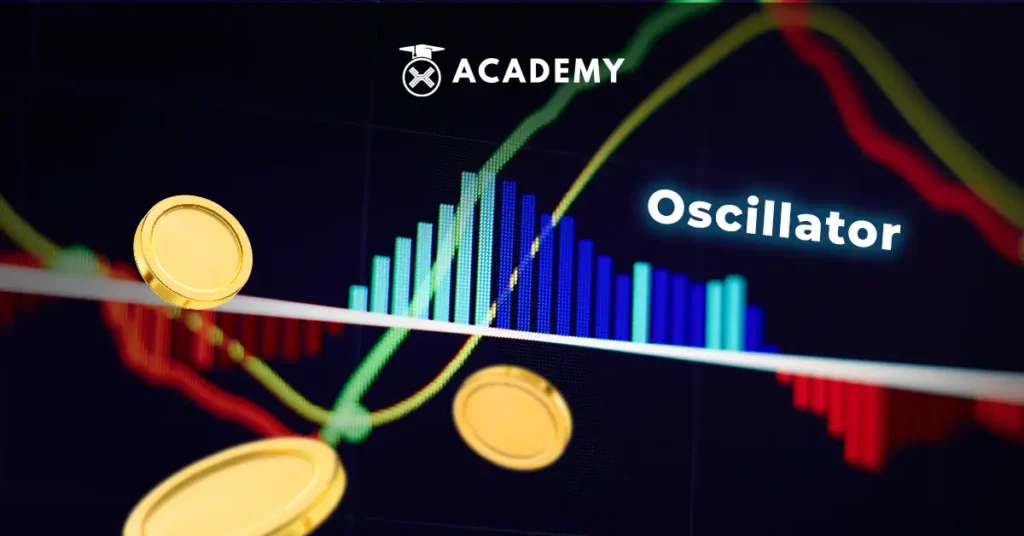In technical analysis, traders utilize various indicators to determine the right time to buy and sell.
One of the indicators used is the oscillator indicator, although its use is optional and not mandatory.
As for technical analysis, several important aspects must be understood, including understanding trends, cycles, support resistance, chart patterns, and candlestick patterns.
Oscillator indicators alone are a small part of helping traders assess the strength of a trend and detect potential signs of reversal. However, their use still requires additional confirmation through candlestick or pattern readings.
Now, to find out what oscillator indicators are, from their definition, indicators to strategies, check out the full review below!
What is an Oscillator Indicator?
Quoting emtrade.id, oscillators are indicators traders utilize to identify overbought or oversold conditions in a stock or crypto asset.
Overbought signifies a situation where the price has reached a high level and may face a potential downward reversal.
On the other hand, oversold indicates when the price has experienced a significant decline and may be due for a technical rebound.
The main function of oscillators is to measure the strength of a trend. However, as mentioned earlier, they are complementary and cannot be used in isolation. Additional confirmation through candle readings is required.
Three Popular Oscillator Indicators & Its Functions

Quoting the emtrade.id page, three oscillator indicators are generally very popular among traders or investors. The three indicators are as follows:
- RSI (Relative Strength Index)
- Stochastic
- MACD (Moving Average Convergence Divergence)
When the oscillator value approaches an extreme value above 70, it indicates that the stock or crypto asset is overbought.
Conversely, the stock or crypto asset is oversold when the oscillator value approaches an extreme value below 30.
If the oscillator value is below 30 and starts to increase, the price of the stock or crypto asset will likely experience a stronger uptrend.
Vice versa, if the oscillator value is already above 70 and starts to decline, this indicates that the price trend of the stock or crypto asset has the potential to slow down.
Stochastic Oscillator Formula and Calculation Example
Quoting hsb.co.id, you can calculate the Stochastic Oscillator value using the following formula, which is:
%K = [(closing price – lowest price in N periods) / (highest price in N periods – lowest price in N periods)] x 100
%D = Simple Moving Average (SMA) of %K in M periods
In the above formula, N and M are periods that can be adjusted according to your preference. Generally, the N period is set at 14, while the M period is set at 3. Here is an example of stochastic oscillator calculation, namely:
Let’s say the closing price of a currency pair in a certain period is 1.2000, the highest price in the previous 14 periods is 1.2500, and the lowest price in the previous 14 periods is 1.1500.
Thus, the following is the calculation of %K:
%K = [(1.2000 – 1.1500) / (1.2500 – 1.1500)] x 100 = 44.44
Then, the %D calculation using the 3-period SMA is as follows:
%D = (44.44 + 55.56 + x) / 3
Suppose in the previous period, %K was 55.56. The calculation of %D is:
%D = (44.44 + 55.56 + x) / 3 = 100 / 3 = 33.33
In the example above, the %K value is 44.44, and the %D value is 33.33.
In application, traders can observe the 80 and 20 levels on the stochastic oscillator to assess overbought or oversold conditions.
In addition, attention can also be focused on the movement of the %K and %D lines, as well as their intersections, as potential clues for buying or selling signals.
Oscillator Mechanics in Technical Analysis
Quoting investopedia.com, in technical analysis, an investor measures oscillators on a percentage scale from 0 to 100, where the closing price is relative to the total price range for a given number of bars in a given bar chart.
Various techniques are used to manipulate and filter multiple moving averages to achieve this. When the market moves within a given range, the oscillator follows the price fluctuations. It indicates an overbought condition exceeding 70 to 80% of the specified price range, signaling a selling opportunity.
An oversold condition occurs when the oscillator falls below 30 to 20%, indicating a buying opportunity. The signals remain valid as long as the underlying security price remains within the set range.
However, when a price breakout occurs, the signals can be misleading. Analysts consider a price breakout as a reset of the range to which the current sideways market is bound or the beginning of a new trend.
During a price breakout, the oscillator may remain in an overbought or oversold range for an extended period.
Technical analysts consider oscillators more suitable for sideways markets and more effective when used with technical indicators that identify the market as trending or sideways.
For example, the moving average crossover indicator can determine whether the market is trending. The oscillator signals become more useful and effective once the analyst determines that the market is not trending.
The Importance of Reading Oscillator Indicators in Trading
In application, the two extreme bands act as momentum indicators and are used as short-term analysis tools.
By looking at the oscillator indicator, traders can determine when to sell or buy an asset they own.
When the oscillator value moves towards higher levels, traders interpret the asset’s momentum is overbought.
Generally, they will sell the asset because they think its demand is too high.
Meanwhile, traders interpret it as an oversold signal when the oscillator value moves toward a lower level.
In this situation, traders generally consider buying the asset as they believe its demand is low.
Therefore, they choose to accumulate the asset, believing that demand will increase shortly and the asset’s price will rise. The signals given by oscillator indicators remain valid if the price movement aligns with the trend.
However, they may become inaccurate when there is a breakout in the asset price, such as when the asset price breaks through a new resistance or support level.
In general, traders more often use oscillator indicators when the price pattern of an asset looks flat (sideways) or fluctuates with high intensity.
This is natural because traders need extra foresight to make the right decisions in these situations.
How to Read Oscillator Indicators

Oscillator indicators are of several types commonly used by traders to confirm momentum signals during trading. These types include a combination of oscillators and other technical analysis indicators.
Some indicators include RSI, MACD, CCI, and Stochastic Oscillator. The following is an explanation of each of them regarding how to read oscillator indicators that are important to know:
1. Relative Strength Index (RSI)
RSI is a technical analysis tool that is often used to provide entry and exit signals.
It does this by measuring the speed of an asset’s price movement and momentum, comparing the closing price and the asset’s lowest price in a given period.
The comparison results in an oscillator score of 0-100. Generally, an asset price is considered to be rising when the RSI line rises above 30.
If the upward trend continues, the RSI line should break 70, allowing traders to enter the market.
On the other hand, an asset’s price trend is considered to be slowing down if the RSI line falls below 70. Most of the time, the RSI line rarely exceeds 70 in a downtrend.
However, it can continue to decline to 30 or even lower. In this situation, traders may consider exiting the market.
2. Moving Average Convergence/Divergence (MACD)
MACD is an oscillator indicator used to spot the price momentum of an asset. Like the RSI, its main purpose is to give traders clues as to when it’s a good time to enter or exit the market for a particular asset.
The MACD indicator has two main lines. The first line is the MACD line, which is generally obtained by subtracting the 12-period Exponential Moving Average (EMA) from the 26-period EMA.
Furthermore, the second line is the signal line, generated from the nine-period EMA, and triggers buy or sell decisions.
A buy signal occurs when the MACD line moves across the signal line. Conversely, a sell signal occurs when the MACD line moves down and crosses the signal line.
3. Commodity Channel Index (CCI)
Another oscillator indicator is the CCI, which compares the current price position to its average price over time. CCI has proven effective in identifying price trend changes (reversals) and measuring the strength of an asset’s price trend.
The CCI provides a score that fluctuates between +100 and -100. A CCI score above +100 indicates a potential overbought condition for an asset, while a score below -100 indicates a possible oversold asset price.
Advantages of Oscillator Indicators
Oscillator indicators certainly provide different added value compared to other technical analysis indicators.
One of its advantages is its ability to provide fairly accurate signals in describing the momentum happening in asset price fluctuations.
Oscillator indicators can provide investors with a clear picture of an asset price’s overbought or oversold condition.
This allows market participants to make buy or sell decisions, especially when the asset price trend shows a balance or “sideways” movement.
Disadvantages of Oscillator Indicators
Despite their many advantages, you need to look carefully at oscillator signals. This is because, while they give you an idea of overbought and oversold conditions, they are not the primary signals for buying and selling when the price trend is very strong.
In fact, in some cases, they can give false signals when bullish or bearish trends are very dominant. It’s important to remember that oscillator signals only provide a snapshot of price momentum in the market.
If you need a more fundamental understanding of the price trend of an asset, then a fundamental analysis instrument may be needed.
Secret Tips and Tricks for Trading with Oscillator Indicators
If we install all the oscillator indicators, it will be complicated to read them because their functions are similar. Using all three oscillator indicators at once is unnecessary in the analysis.
Instead, we can choose one oscillator as a complementary indicator in the analysis. In principle, the simpler, the better.
If you want to know whether the price is cheap or expensive for investment purposes, you can check the monthly chart of the stock.
Use oscillator values between 30-70 because assets rarely have good fundamentals and oscillator values on the monthly timeframe below 30.
Of course, in investing, we should do fundamental analysis before technical analysis, which is the last priority. Technical analysis helps us determine the right time to invest after we have analyzed the business model, management, profitability, fundamental outlook, and valuation.
Furthermore, the numbers that indicate oversold and overbought conditions cannot be used as a fixed benchmark or interpreted absolutely.
Sometimes, upon entering the oversold region, which is above 70, a stock or crypto may just be coming out of a downtrend phase and experiencing improvement to transition into an uptrend.
Remember, as discussed earlier, confirmation from candle readings and trends is still required. It is possible that even though the oscillator value is high above 70, there is a breakout or continuation of the bullish trend because the main trend is up.
Conclusion
In technical analysis, oscillator indicators play an important role as tools to help traders understand market conditions and potential trend changes.
However, it’s important to remember that these indicators have weaknesses, and their signals need to be confirmed with other analyses, such as candle and trend readings.
Furthermore, as a disclaimer, it is important to trade wisely and understand that no indicator is perfect. Therefore, they should be used as a supplement to analysis, not the sole basis for decisions.
Any trading decision should be based on a thorough understanding of market conditions and a combination of indicators.
It is important to understand that mastering oscillator indicators requires in-depth understanding and experience. Therefore, traders need to continue to learn and hone their skills in using this indicator as one of the keys to success in trading, which you can learn from a collection of crypto articles on INDODAX Academy.
Invest in Crypto Assets on INDODAX
Now you know what an oscillator indicator is, starting from understanding indicators to strategies.
Furthermore, if you are interested in investing in crypto assets, you should check the crypto market only at INDODAX Market.
After checking the price, you can purchase crypto assets only on a trusted crypto exchange, INDODAX.
It is also important to note that INDODAX is the most popular crypto asset trading platform and a pioneer in providing crypto asset trading services in Indonesia.
With an excellent reputation as a crypto asset trading platform, INDODAX consistently provides reliable services for investors.
In addition, INDODAX also plays an important role in providing easy access to the crypto asset market while ensuring transaction security for all platform users.
As a disclaimer, it is important to understand that any decision related to crypto asset investment should be based on careful research and a deep understanding of the risks.
This is because the value of crypto assets can fluctuate significantly due to their high volatility. Therefore, it is important to remain cautious and prudent in investment decisions.
Start investing in crypto assets right now only with INDODAX!








